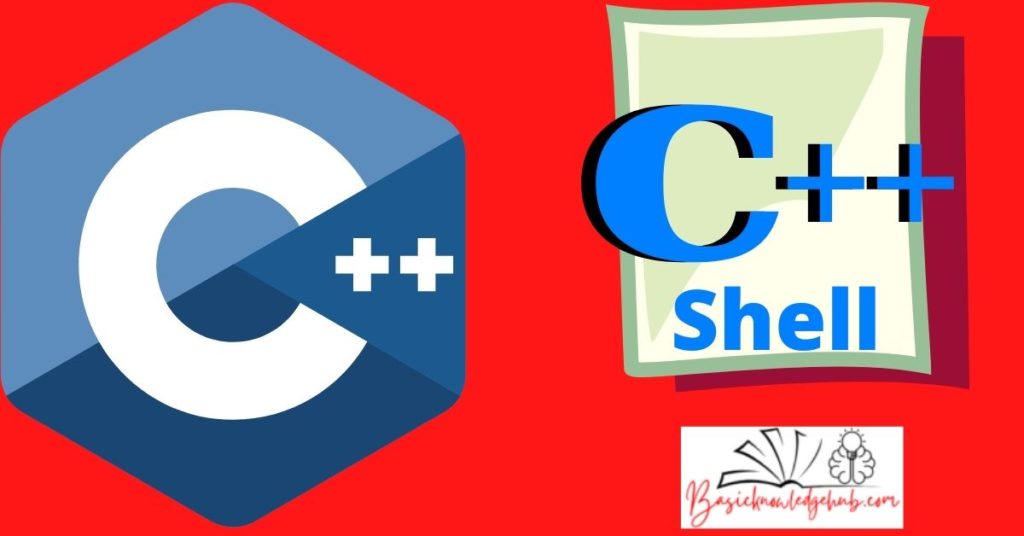C++ Shell
Shell – a term very common word for everyone. People, with no technical knowledge, know about it as a protective animal covering or outside covering of an egg. People having some technical knowledge regarding computers and programming are familiar with it with a different meaning. So, let us start from the beginning. First let us know, what is a shell and c++shell?
Shell
A computer program that reveals the services of the operating system to a user is known as the shell. The users are provided with various services by the operating system. The services include management of files, processes applications, batch processing, and system monitoring. The shell in the operating system is an interface to the kernel inside it. The shell, with the help of input/output devices, keeps in touch with the user. The interaction between a user and system is managed by the shell by handling the user input, interpreting them, and handling output by the system. The shell is an application and can be removed by any other application. The shell can be an interactive or non-interactive user interface also used in C++.
Shell uses a CLI (Command Line Interface) or a GUI (Graphical User Interface) depending on the role of the computer and the operations that are to be performed. The shell is the layer of the operating system which is the outermost part. CLI is used in cases, where the user needs to be accustomed to writing commands. The user needs to know the commands along with their syntax and understand the concept of scripting language specifically with the shell. In GUI, the user has a graphical interface and just needs drag-drop-click concepts that are easy to use. There are advantages of GUI as well as disadvantages too.

Command Line Interface:
In Command Line Interface, the user needs to type the codes on the keyboard to give the command to the operating system. In the past, the users could communicate with the computer only with the CLI. There are a variety of shell programs in CLI with command and their specific syntax. The user needs to be careful when using the CLI. Any command which is not typed with proper spelling or syntax can lead to huge errors. The command-line interface is usually used by application programs. The sequence of commands can be saved in CLI for reuse.
The interpreter can also expand codes of a few characters which the user has input. These are the special features of CLI including many others. The user can see all the typed codes in CLI by its history function. The users can easily see the codes they typed and rewrite them with some modification. CLI is in designing computers, accessing features, and installing software by Software Developers and System administrators.
Graphical User Interface:
In a graphical user interface, users can handle programs graphically. The components in the system are visually interactive. GUI was created as the users found CLI complicated and difficult to learn. We can open, close, modify, move or resize the programs by drag-drop-click mechanism. The focus of the windows can also be switched by the users. Files in GUI are represented as a realistic image. The application programs have a graphical representation and the objects interact with the users. The actions that the users can perform are changing colors, size, and renaming of the application.
The objects are portraited with icons, buttons, and visual indicators (cursor). Visually the applications look nice and feel like they are in the physical world. GUL is user-friendly as it is easier to learn and make use of it. There is the ease of performance as the users need not know anything about the application programming. Some Linux variants, Windows and Mac OS make use of the graphical user interface.
Responsibilities of Shell:
The shell has various responsibilities such as:
Program Execution:
When the user requests for the execution of any commands, the shell takes this request and is responsible for executing those commands. The shell analyses the lines typed in the terminal and determines the action to be done.
Substitution of variable and filename:
Users can assign value to the variables. When users assign a value to a variable preceded by a $ sign, that value is substituted by the shell. The command line is scanned by the shell to substitute the filename of programs.
Input-Output Redirection:
The shell is also responsible for the input/output redirection of characters and words on the command line. The command line is scanned to find special redirection characters such as <, >, >> or << and the shell takes a filename as the next word in the command line. The output of the program is redirected to the indicated file by the shell. The program does not know that its output is being redirected by the shell.
Hook up of Pipeline:
The shell looks for pipe characters in the command line. When the shell finds a pipe character, it connects the output from the preceding command to the input of the command. The execution of the commands is then initiated. When the users type the commands, the shell finds the pipe symbol separating them. The output of the preceding command is connected to the input of the antecedent command and then executes both of them. The preceding commands do not know that they are not going to the terminal but another command. The antecedent command is unaware of the fact that the input is not coming from a terminal but a command.
Control on Your Environment:
The users are provided with certain commands that let them personalize their working environment. The home directory, characters that display in the prompt, search results, all included in our environment.
Interpreted Programming Language:
The programming language of the shell is an interpreted language, which is of its own. The statements in each line are analyzed one by one by the shell and then is executed by them. Shell differs from most programming languages that compile their code before execution in machine-executable form. Shell programs are easier to debug and modify but they take a longer time to execute. It’s programming language has features common to the other programming languages like having loops, decision statements, functions, and variables.
Now that we know what is a shell, let us move to C++ Shell In programming, the operating system’s application programming interface (API) is made in C language. When we call C functions, C++ language provides direct support for it. So, C++ becomes a system programming language in such a case. When we call the operating system, we use the “System ()” command. To execute the C++ shell, we use a system command.
Don’t miss: Odin NAND Erase | What is NAND for Android phones? | How to erase it?
System Call in C++ Shell:
In the C or C++ standard library, we find the system () function. Commands that execute in command prompt or terminal are invoked by the system () command. It also returns the commands after their execution is completed in the terminal. When we do a system call in C++, we need to add stdlib.h and cstdlib in the codes.
We can use the system () command to execute codes that are running on the terminal of an operating system. System () is also used to call GCC (GNU Compiler Collection) compiler in our program. This command is also used to implement a pause command and keep the terminal or the screen in a pause. If we use the cls command with the system command then it will clear the screen of the terminal. Using system command is not always feasible, however, there are few reasons to avoid using system command:
- The function call by system command is heavy and very expensive on resources.
- System commands only work at the system level like having pause commands in Windows. It is not portable to use in Linux, MAC or any other operating system.
- The operating system has the system command dependent on it.
- Our program is suspended and the OS shell is invoked to open by system command.
- More memory is allocated for the pause command by the operating system.
Code of the C++ Shell System Call:
The default function prototype of the C++ system call is int system (const char* command);
When the command is executed, a C string is passed in it. This code returns an integer value depending on whether the string is an argument or the pointer specified is null. If the pointer is null then it returns a zero value. It will return a non-zero value when the command processor is available. It will be executed by the system command when a command is supplied as an argument. System and Library implementation decide the value returned by the command. When we use the system () function, we can execute any command that the operating system allows.
C++ Shell System Pause:
When the system pause command is executed, the operations in the system are temporarily halted. This command is dependent on the operating system. It gives a signal to the OS to open the OS shell and suspends programs for short period. The OS has to allocate some memory for the system pause command to execute. After the suspended command is resumed, the OS deallocates the memory. After the code is executed, the cin.get command can be used to halt the output until the users press some key. It is the commonly used system call command along with cls.
Conclusion:
Shell is a common term for all people. People might know it as a covering of animals or a covering of eggs. People having technical knowledge know it as an application that connects the users with the kernel. The users interact with the shell directly and then, the shell passes their commands to the kernel to execute it. The shell keeps in touch with the users with the help of the input/output device. The shell can interact in two ways with the users: 1. Command Line Interface and 2. Graphical User Interface. In CLI, the users have to type codes to interact with the shell and in GUL, the programs are handled graphically. GUI has ease of use and is popular among users.
A shell has various responsibilities including program execution, Substitution of variable, and filename. The other being Input-Output Redirection, Hook up of Pipeline, Control on Your Environment, and Interpreted Programming Language. The operating system’s application programming interface (API) is made in C language in programming. C++ language provides direct support for C functions. So, C++ becomes a system programming language in such a case. C++ Shell uses system calls. However, there are various reasons why it should not be used very often. C++ Shell has a default function prototype. It uses a function system pause to halt some programs or suspend them for a short period. It is an OS-dependent command and memory is deallocated when the suspended command is resumed.


